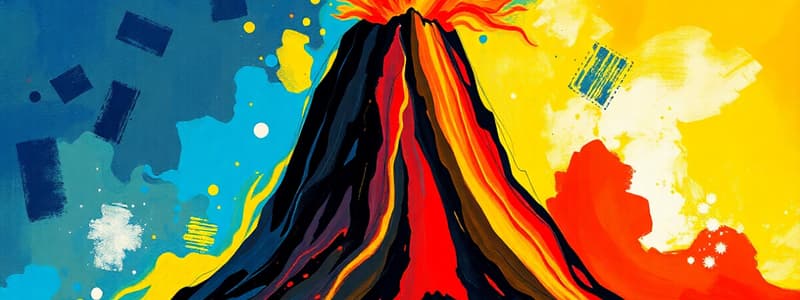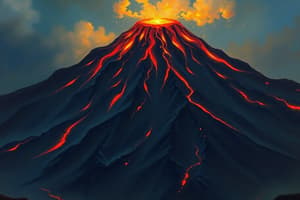Podcast
Questions and Answers
What is a volcano?
What is a volcano?
An opening or rupture in a planet's surface or crust that allows hot magma, volcanic ash, and gases to escape.
Volcanism only refers to the eruptions of volcanoes.
Volcanism only refers to the eruptions of volcanoes.
False (B)
Volcanoes are formed when two tectonic plates _____ together.
Volcanoes are formed when two tectonic plates _____ together.
push
Which of the following are main parts of a volcano? (Select all that apply)
Which of the following are main parts of a volcano? (Select all that apply)
What forms a caldera?
What forms a caldera?
What type of lava is known as 'ropy lava'?
What type of lava is known as 'ropy lava'?
The _____ is the tube-like passage that connects the magma chamber to the surface.
The _____ is the tube-like passage that connects the magma chamber to the surface.
What are volcanic bombs?
What are volcanic bombs?
Lava flows can extend for many kilometers and may destroy anything in their path.
Lava flows can extend for many kilometers and may destroy anything in their path.
Flashcards are hidden until you start studying
Study Notes
Volcanoes and Volcanism
- Volcanoes are openings in the Earth's crust that allow hot magma, ash, and gases to escape.
- Volcanism encompasses all volcanic activity, from magma formation to eruptions.
- Volcanoes are named after Vulcan, the Roman god of fire.
Volcano Formation
- Volcanoes form when tectonic plates collide, forcing magma from the mantle to the surface.
- This occurs at oceanic-continental boundaries, where the denser oceanic plate is subducted beneath the continental plate.
Stages of Volcano Formation
- A crack in the Earth's crust extends to the surface and widens.
- Smoke escapes through a vent.
- Molten rock, or magma, erupts from the vent, often accompanied by ground shaking.
- Magma reaches the surface and flows as lava.
- Lava cools and solidifies, accumulating around the vent.
- A cone-shaped landform develops.
- The cone grows into a volcano.
Main Parts of a Volcano
- Magma Chamber: A large underground reservoir of molten rock (magma) that feeds the volcano.
- Vent: An opening in the Earth's crust through which magma, gases, and ash escape.
- Main Vent: The primary channel for magma flow.
- Secondary Vent: Smaller openings on the volcano's sides.
- Crater: A bowl-shaped depression at the volcano's summit, formed by explosive eruptions or summit collapse.
- Caldera: A large depression formed when a volcano collapses into itself after an explosive eruption.
- Ash Cloud: A cloud of volcanic ash and gases released during an eruption.
- Conduit (Pipe): The tube-like passage connecting the magma chamber to the vent.
- Parasitic Cone: A smaller cone formed on the side of a larger volcano by secondary vents.
- Fumaroles: Openings that release volcanic gases like steam, carbon dioxide, and sulfur dioxide.
- Volcanic Bombs: Large fragments of lava that solidify in the air before falling to the ground.
- Tephra: A general term for all volcanic debris, including ash, pumice, and bombs.
- Sill: Flat rock formed when magma hardens in a crack in the volcano.
- Flank: The side of the volcano.
- Lava Flow: The movement of molten rock that pours out of a volcano.
Types of Lava
- Pahoehoe: Smooth, ropy lava that flows slowly.
- A'A: Rough, clumpy lava that flows quickly and forms a jagged crust.
- Blocky Lava: Lava with irregular surfaces and large, smooth-sided, angular blocks.
Lava Characteristics
- Molten rock with temperatures ranging from 700 to 1,200 °C.
- Color changes with temperature:
- Bright yellow over 1,000 °C
- Orange (800-900 °C)
- Dull red (600-700 °C)
Studying That Suits You
Use AI to generate personalized quizzes and flashcards to suit your learning preferences.




